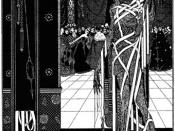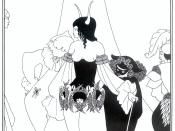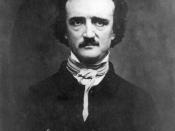Poe uses The Oval Portrait to make a comment on life, particularly on things that he may have missed out on, for one reason or another. In particular, love, beauty, and seeing the truth about life. The narrator is the vehicle he uses for his contemplation, although there are other characters that embody his emotions.
The narrator, who is obviously badly wounded, even perhaps dying, has come to a chateau, where he has a chance to reflect on things while he is recuperating. The two characters at the beginning of the story, Mrs Radcliffe, and a valet named Pedro, are a mother and father type caring figure respectively. Poe himself never really had parents, and so this is his way of living out his dreams.
The candelabra, which the narrator uses to firstly read about the paintings on the wall, is the object which sheds true light on the portrait.
This is like a reflection where he realizes what is going on in his life. He sees in the young woman in the portrait everything he is lacking in his life, beauty, love, freedom in life. He likens himself to the painter, who though he honours and displays the beauty in his paintings, he is unable to feel, and touch and experience the fullness of life.
Poe is trying to say that it is only when we reach the end of our lives that we can truly sit back and appreciate the beauty in life. Often times it can take a new light to see the truth lurking in the shadows, perhaps in denial by ourself. Poe regrets not taking the time to experience the fullness of life, either getting caught up in trying to live out his life, that he forgets to stop and smell the roses.
The Masque of the Red Death is a comment on the inevitability of death, and the progression of life. In a time where death is everywhere in the world, Prince Prospero believes that he is above and beyond death, that in locking himself away in a castle, he can escape it. The party-goers in the story likewise try to shun death by revelling in life, and trying to ignore the ticking death clock.
The seven apartments represent different stages in life, the earlier apartments are in bright and lively colours, while the last two, scarlet and black, represent the old age, and dying. In the final apartment, there is a clock, which is forever ticking, counting down the divisions of time until death comes. The sound of the clock carries throughout the apartments and over and around the party-goers and yet they try to ignore it with their revelry.
Significantly, when the red masked man appears, being death himself, he appears from the early apartments, meaning that death can come at any time, from anywhere. The prince is furious, trying to prevent the inevitable by saying that it isn't the time for death. All of those at the party are in their prime, and there is no place for death. When he tries to kill the masked man, it is insubstantial. In this, Poe is saying that death is untouchable, a certainty, everyone tries to fight it, but in the end all will die when it is their time.
When Poe was a young man, he lost members of his family, and was in the army, this was his way of dealing with death, but at the same time grieving for his losses. Poe is telling us to enjoy life while we can, but to realize that at the end of our lives, whenever it comes, we will all have to answer to the death clock. Enjoy it while you can, he says, but don't try to fight the inevitable.


